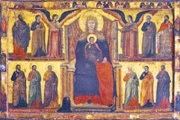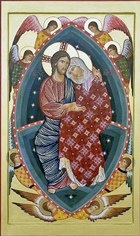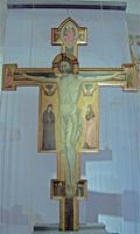

The Maestro di Cesi is named for one of the few works of art in Umbria in the early 14th century that bears a date (see below). Although this autograph work was painted for a church in Cesi, there is no particular reason to believe that he was a native of this town. The two other works attributed to him were both painted for a nunnery in Spoleto, which was a much more important artistic centre.
Cesi Dossal (1308)

The autograph work of the Maestro di Cesi is a dossal (1308) that was probably painted for San Michele Arcangelo (see the Walk around Cesi). The central part of the composition depicts the Madonna and Child enthroned with a kneeling female donor, who is named in the inscription (see below) as Domina Elena.
Small standing figures are arranged in two registers to the sides of the central motif:
-
✴SS Paul, John the Evangelist and Michael Archangel (upper right);
-
✴SS Gabriel Archangel, Peter and John the Baptist (upper left);
-
✴SS Bartholomew, Luke and Mark (lower right); and
-
✴SS Andrew, Thomas and Matthew (lower left) .
The dossal survives in its original (damaged) frame, which has: standing saints to the sides; angels and the symbols of the Evangelists above; and the inscription with the date and name of the donor below.
The dossal is now in the Museo Parrocchiale, Cesi (see the Walk around Cesi).
Triptych (early 14th century)

-
✴The central panel (illustrated here, courtesy of the Comunità Missionaria di Villaregia) contains a representation of the Assumption of the Virgin in which Christ embraces His mother as they ascend to Heaven in a mandorla carried by angels. This iconography is similar to that in the fresco by Cimabue on the altar wall of the upper church of San Francesco, Assisi, in which Christ and the Virgin sit side by side in an intimate pose as angels bear them to Heaven. For more information on this interesting iconography, see this website by Andrea Lonardo.
-
✴(The preponderance of stars in the composition reflects the dedication of the church).
-
✴The side panels contain eight scenes that depict the events leading up to the Virgin’s death.
The triptych was documented in Santa Maria della Stella in 1861, some 60 years after it had been converted into a barrack and the nuns had left for the Monastero della Passione, Spoleto. (It is possible that the nuns had taken it with them, and that the new nunnery was known by the title of their old one in 1861). The triptych was documented again, this time in the Monastero della Passione, in 1872, but it was subsequently sold illegally. Giuseppe Sordini tried to locate it in the period 1892-4 but failed.
The scholar Millard Meiss (see below) found the triptych in the collection of the Rothschild family at Villa Ephrussi de Rothschild, Saint-Jean-Cap-Ferrat, France: it was badly in need of cleaning and had been dismembered. He did not know of its provenance but his stylistic analysis led him to attribute it to the Maestro di Cesi. The triptych was restored and re-assembled in 1984-90 at the Louvre, Paris, prior to its inclusion in an exhibition there. The scholar Marilyn Aronberg Lavin (see below) recently identified it as the lost work from Santa Maria della Stella. It is now in the Musée Marmottan, Paris but is not exhibited. (An illustration of the whole triptych is available on the website of the Bridgeman Art Library).
Christus Triumphans (early 14th century)

-
✴Christ in judgment appears at the top;
-
✴the Virgin and St John the Evangelist stand to the sides, below chalices that collect the blood of Christ;
-
✴SS Stephen and Thomas stand at the ends of the horizontal beam of the cross; and
-
✴SS Francis and Dominic kneel at its foot.
The Crucifix is now in Room 9 of the Museo del Ducato di Spoleto, Spoleto.
References:
Millard Meiss, “Reflections of Assisi: a tabernacle and the Cesi Master”, in “Scritti di Storia dell’ Arte in Onore di Mario Salmi”, (1962) Volume 2, pp 75-111.
Marilyn Aronberg Lavin, “Stella Altarpiece: Magnum Opus of the Cesi Master”, Artibus et Historiae, 22 (2001) 9-22.

